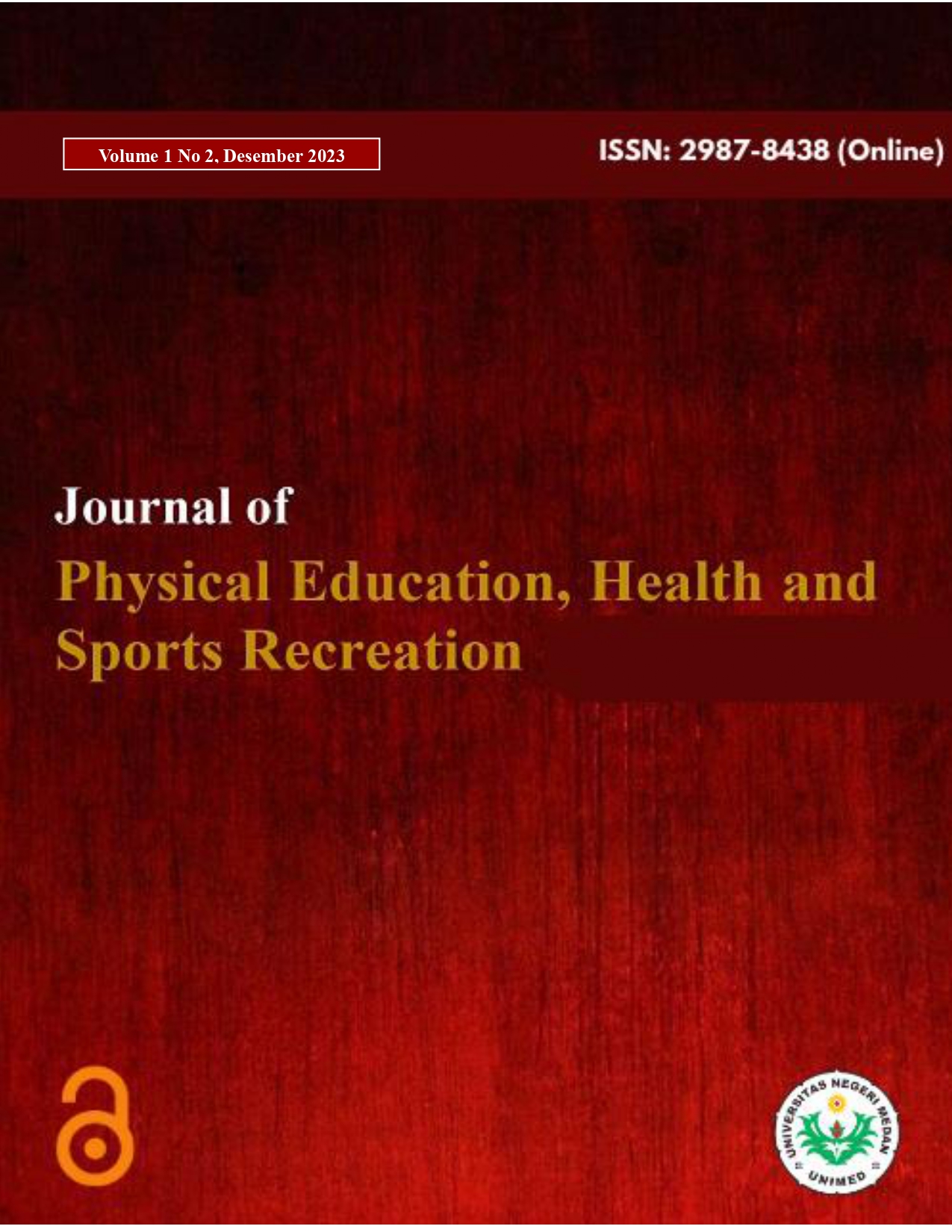DEVELOPMENT OF A MULTIMEDIA-BASED MULTIMEDIA-BASED LEARNING MODEL FOR BASIC LOB FOREHAND BADMINTON BETTING TECHNIQUES IN TENTH CLASS STUDENTS 4 MEDAN STATE VOCATIONAL SCHOOLS
DOI:
https://doi.org/10.24114/jpehsr.v1i2.49192Keywords:
Pengembangan, teknik dasar, pukulan lob forehand, permainan bulu tangkis, multimediaAbstract
The problem that occurs in the learning process is the need for interesting and fun media so that it can build student motivation and make it easier for students to carry out the basic techniques of playing badminton. This research aims to produce a product in the form of an animated video and a guide book. The learning process is carried out using multimedia-based media. Learning media for basic forehand lob techniques for class ten at SMK Negeri 4 Medan. This research method is research and development (Research and Development sugiono), which uses eight steps in development research. With a small scale respondent of 10 students and a large scale trial of 20 students. Based on expert validation of the multimedia-based basic badminton lob forehand technique learning model for vocational high school students including 93.75% material experts and 90% media experts. Small scale trial feasibility was 74.12%. Large-scale trial feasibility was 88.43%. Overall, the learning media model for learning the basic techniques of badminton forehand lob strokes based on multimedia for class X students at SMK Negeri 4 Medan is very suitable for use after going through several trial stages.References
Aji, R. B., & Komari, A. (2018). Tingkat Kemampuan Pukulan Lob Bulutangkis Peserta Ekstrakurikuler Bulutangkis Di SD Budi Mulia Dua Panjen Yogyakarta PGSD Penjaskes. 7(7). Retrieved from http://journal.student.uny.ac.id/ojs/index.php/pgsdpenjaskes/article/view/11285. Di akses selasa, 07/03/2023 pukul 14.16 WIB.
Ariyus, D. 2009. Keamanan multimedia (1 st ed). Yogyakarta: CV Andi Offset.
Armanda, B, C., Adi, S., & Widiawati, P. (2021). Pengembangan Model Latihan Teknik Dasar Pukulan Lob dan Smash Bulutangkis Usia 8-12 Tahun di PB IMARA Kota Kediri Berbasis Android. Sport Science and Health, 3(10). ISSN: 2715-3886. https://doi.org/10.17977/um062v3i102021p784-789. Di akses minggu, 02/04/2023 pukul 17.12 WIB.
M. Sajoto. 1995. Peningkatan dan Pembinaan Kekuatan Kondisi Fisik. Semarang : Dahara Press.
Rusli Lutan dan Adang Suherman. 2000. Pengukuran dan Evaluasi Penjaskes. Jakarta : Depdiknas.
Safitri, Dian, And Dika Ramadani. (2021). Prestasi Atlet Bulutangkis Putri Indonesia Di. Edukasimu . 1(2): 1“ 8. Di akses senin, 06/03/2023 pukul 14.16 WIB.
Sakurai, S., & Ohtsuki, T. (2000). Muscle activity and accuracy of performance of the smash stroke in badminton with reference to skill and practice. Journal of Sports Sciences, 18(11), 901“914. https://doi. org/10.1080/026404100750017832. Di akses selasa, 07/03/2023 pukul 14.07 WIB.
Sugiyono. 2009. Metode Penelitian Kuantitatif, Kualitatif dan R & D. Jakarta : Alfabeta.
Sugiyono. 2008. Metode Penelitian Kuantitatif Kualitatif dan R&D. Jakarta : Alfabeta
Sugiyono. 2012. Metode Penelitian kuantitatif kualitatif dan R&D. Cetakan Ke-17. Bandung : Alfabeta.
Sugiyono. 2014. Metode Penelitian Kuantitatif, Kualitatif dan R&D. Jakarta : Alfabeta.
Suharno HP. 1984. Ilmu Kepelatihan Olahraga. Yogyakarta : Yayasan STO.
Sung, N.-J. J. W. C.-H. A. M. (2017). Implementation of Badminton Motion Analysis and Training System based on IoT Sensors. Journal of Internet Computing and Services, 18(4), 19“25. https://doi.org/10.7472/JKSII.2017.18.4.19. Di akses selasa, 07/03/2023 pukul 17.15 WIB.
Susanto, Ratno. (2017). Pengembangan Model Latihan Forehand Dropshot Bulutangkis Pada Siswa Ekstrakurikuler SMPN 2 Trawas Mojokerto. Jurnal Kejaora, 2(2). ISSN: 2541-5042. https://ejournal.unibabwi.ac.id/ index. php/ kejaora/article/view/127. Di akses minggu, 02/04/2023 pukul16:23 WIB.
Suyanto, M. 2005. Multimedia alat untuk meningkatkan keunggulan bersaing (2 nd ed.). Yogyakarta: CV Andi Offset.
Syafruddin. 2011. Ilmu Kepelatihan Olahraga Teori Dan Aplikasinya Dalam Pembinaan Olahraga. Padang : UNP Press Padang.
Downloads
Published
Issue
Section
License
Copyright (c) 2023 Rizki Jaharuddin Dalimunthe

This work is licensed under a Creative Commons Attribution-ShareAlike 4.0 International License.
Authors who publish with this journal agree to the following terms:
Authors retain copyright and grant the journal right of first publication with the work simultaneously licensed under a Creative Commons Attribution License that allows others to share the work with an acknowledgment of the work's authorship and initial publication in this journal.
Authors are able to enter into separate, additional contractual arrangements for the non-exclusive distribution of the journal's published version of the work (e.g., post it to an institutional repository or publish it in a book), with an acknowledgment of its initial publication in this journal.
Authors are permitted and encouraged to post their work online (e.g., in institutional repositories or on their website) prior to and during the submission process, as it can lead to productive exchanges, as well as earlier and greater citation of published work (See The Effect of Open Access).
This work is licensed under a Creative Commons Attribution-ShareAlike 4.0 International License.

